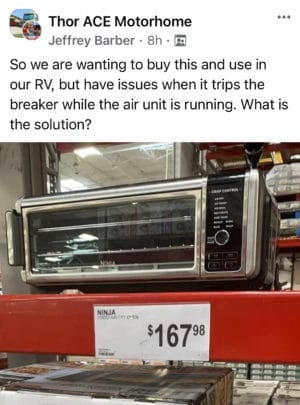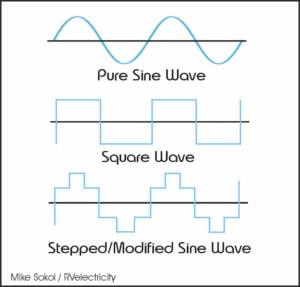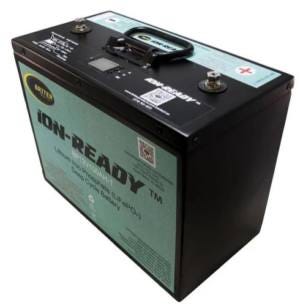Dear Mike,
I have an inverter question. I have a new van and want to use only an inverter to power things like my toothbrush or my phone, etc. Except I love my Ninja Foodi air fryer. I have an 800-watt and an 1800-watt inverter but the second takes up a lot more space than the first. Will the Ninja run on the lower watt power source but just not get as hot? Does it have any diodes that would not allow it to work at all? Will I ruin it if I try? -Louise
Dear Louise,
These air fryers are getting really popular…. they make tasty food rather quickly with little or no oil. And it’s a lot healthier than frying it in lard (even though I love my wife’s pan fried chicken in Crisco). So let’s explore just how much power one of these take to operate and see how much inverter and battery power you really need.
What’s a Ninja® Foodi™ Air Fryer?
Here’s what a Ninja Foodi Air Fryer Oven looks like on a store shelf. And you can see from the question in the Thor ACE Motorhome group that you are not alone. In fact, I’m getting a similar question every week or so.
While this air fryer resembles a toaster oven at first blush (and yes, it can do that function, as well), it really shines when you crank up the high-temperature convection setting to “air-fry” mode. That’s when it draws the maximum of 1,460 watts for 10 to 15 minutes while it does its fry thing. To find out how much amperage that is at 120 volts, we simply divide 1,460 watts by 120 volts, which we find equals 12.16 amps of current.
Is this a problem?
That’s not a huge load on a 20-amp kitchen outlet in your sticks-and-bricks home. But how much amperage would it draw from your RV house battery while doing it? In that case we simply divide 1,460 watts by 12 volts which equals 121 amps of current. Better include another 10% for efficiency loss, so let’s call it 135 amps or so.
Can an 800-watt inverter power it?
Definitely not. In fact, the inverter should trip off its internal circuit breaker within seconds, if not sooner. While it probably won’t hurt the inverter or the Ninja, it’s definitly not going to work.
Can an 1,800-watt inverter power it?
Most likely, yes, but only if it’s a Pure Sine Wave Inverter, not a Modified Sine Wave (MSW) Inverter. As you can see from my diagram, an MSW inverter creates all sorts of harmonics up to 45% distortion, and that can easily wreck the control circuity in your Ninja Foodi, so don’t try it.
In fact, an MSW inverter can burn up your electric blanket controller, and cause your computer power supply to overheat. In short, never use a Modified Sine Wave Inverter to power anything with onboard electronics, which today is practically everything that plugs in.
What else can go wrong?
It’s not just about the instantaneous wattage required. That 135 amps from your battery is going to be drained rather quickly. If you have a 100 Ah (amp-hour) flooded lead acid or AGM battery, it really shouldn’t be discharged below 50% of capacity regularly, which means 50 Ah of usable capacity.
So, to calculate how long a 135-amp load can be powered, we just divide 50 amps by 135 amps, which equals 0.37 hours. Multiply 0.37 times 60 minutes and you can see that 22 minutes under full air fry power will drain your battery to 50% State of Charge (SoC).
If you have a 100 Ah Lithium battery, the numbers are better, since you can discharge it down to 0% SoC without damage. So, you might get 45 minutes of air frying time before your RV’s 100 Ah Lithium battery is completely dead.
What about the wires?
Also, be aware that you’re going to need to run a very heavy conductor between your battery and the 1,800-watt inverter so that it doesn’t overheat and melt down. So, I would run 1/0 copper with a 150-amp fuse to protect it from over-current.
If you don’t install this type of wiring correctly you can easily cause an overheated wirev and a fire. So, don’t do this yourself if you’re not already competent at running heavy gauge wiring. This is not a Learn on the Job kinda install…
You might need a second Lithium battery
Also, all Lithium batteries have built-in over current protection, so it’s possible you might need a second battery in order to supply more than 100 Amps of current. Yikes!
Is there any good news?
Sadly, no. If you want to run an air fryer for 15 minutes or more in an RV from battery power, it will require at least an 1,800-watt Pure Sine Wave inverter, plus perhaps a second 100-amp-hr (or more) Lithium battery, plus short runs of 1/0 copper conductor. There’s just no way around it.
These air fryers are real energy hogs which are happy in your house or even your RV while plugged into shore power, as long as you’re not running a lot of others things (like the air conditioner) at the same time. TANSTAAFL (There Ain’t No Such Thing As A Free Lunch).
OK, everyone. Remember that electricity is a useful and powerful force, so we all need to pay attention to safety precautions while using it.
Let’s play safe out there…. Mike











While I agree 100% with Mike’s analysis of the electrical problems with running an air fryer on an inverter, there is an alternative: get a propane powered air fryer: I haven’t tried this myself but a quick search turned up this one (and I’d guess there are others):
Charbroil® The Big Easy TRU-Infrared Cooking Technology Propane Gas Stainless Steel Oil-Less Turkey Fryer - 17102065 https://a.co/d/1ltbcca
At ~ $110, this seems like a good alternative but, since it’s big enough to cook a turkey, it might be challenging to bring along in a camping trip. The dimensions are:
20.75 x 16.3 x 23.5 inches and it looks from the picture like it’s a bit larger than a 20 lb propane tank. It is rated at 16k BTU and they say it takes 8-10 minutes per pound. For a 15lb turkey cooking for 150 minutes, you would use less than 25% of a tank of propane. As Mike has reported repeatedly there is 128 kW-hr or 430,000 BTU in a 20 lb propane tank. That’s the equivalent of 12-100-hour lithium batteries! Now if there is a smaller size one out there, or you can just be happy with a small gas grill, you are in business!